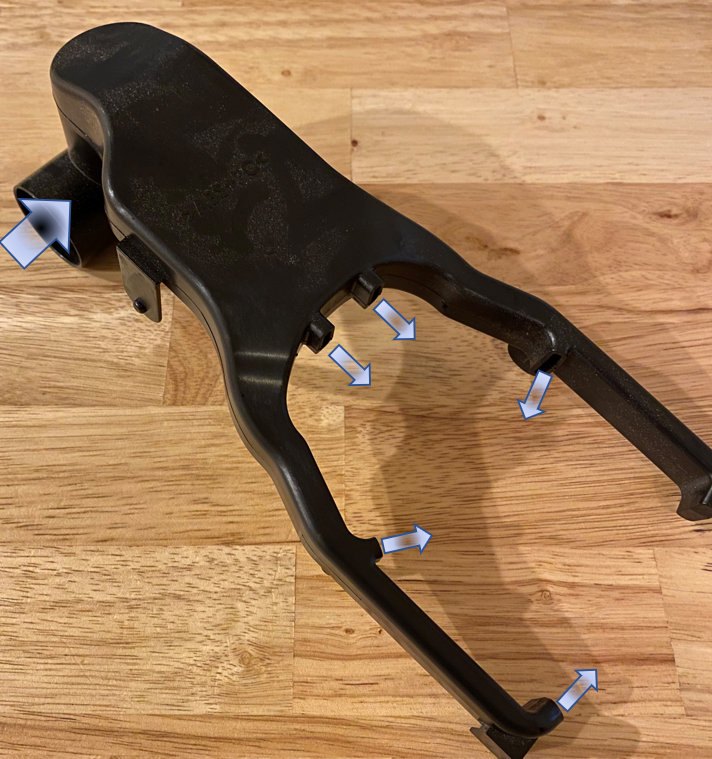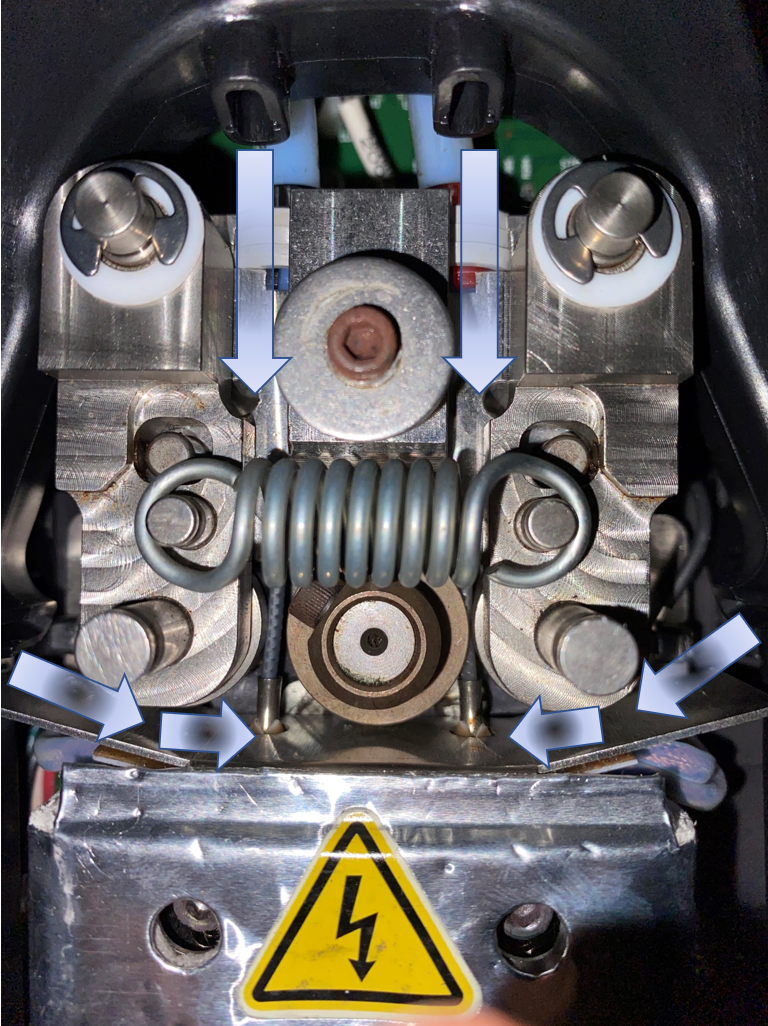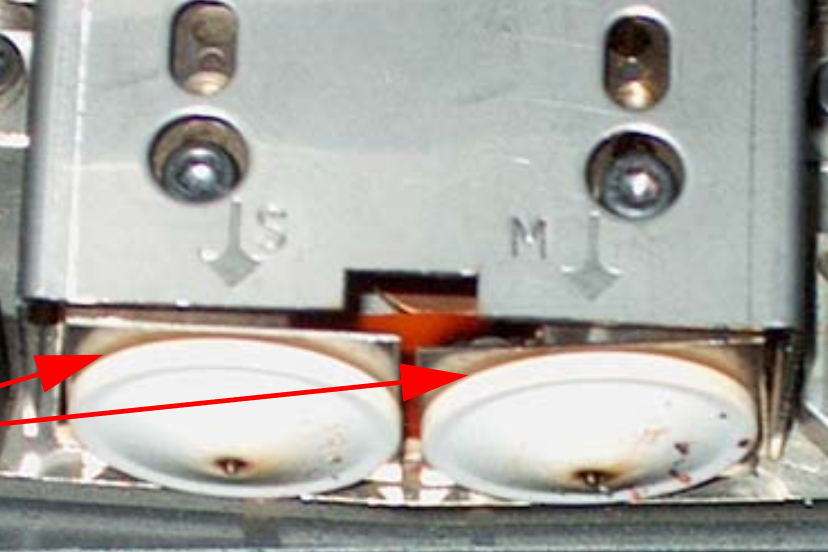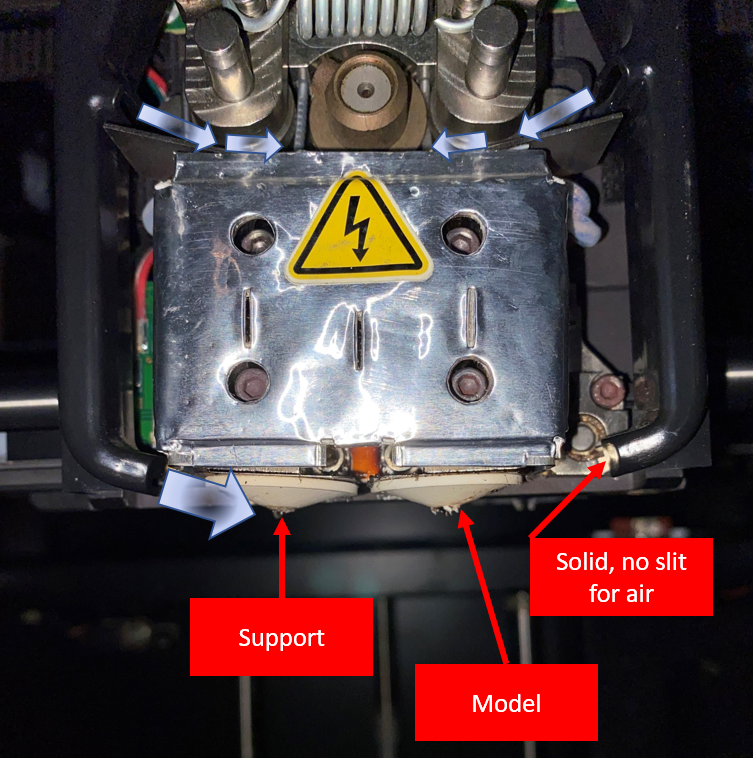What happens to the temperature inside your nozzle?
-
@deckingman said in What happens to the temperature inside your nozzle?:
........... whatever makes you happy.

I have a Stratasys BST 1200es in my garage - here is how they separate part cooling and "heatbreak" cooling.
On the print head is an air plenum, where an "umbilical cord/tube" is attached, with the airflow powered by a 120VAC blower fan. This air is drawn from outside of the printer - so assume 25°C or so.

Both the support (left) and model (right) material are extruded with the same DC motor. Some air is directed downward, parallel to the filament, while some is directly just about perpendicular to the filament (right above where it enters the heater).

You can see below that, directly above the heater, there is an angled metal sheet that lines up pretty close to the outlets of the horizontal filament cooling air, controlling the direction of the air and preventing it from passing down towards the print nozzle.
The Dimension series has a heated chamber, set to ~72°C, with the heated air directed over the build plate at roughly the height of the current layer being printed. On the print head air plenum there is a slit on the support side, directing ~25°C air towards the currently printed area. I am unsure if this print cooling air is used only for support or if its for both, as the print head moves depending on what material is selected - if model is selected, it looks like the support nozzle and tip shroud blocks the airflow somewhat. As a note, this blower fan does not turn off except in certain maintenance modes, so the cooling air is not turned off depending on what material is being printed.
The tip shrouds cover a significant amount of nozzle tip, so the impacts of the cooling air (or even blowing chamber air) is limited.

When compared to "reprap" style hotend setups, "heatbreak" cooling flow is quite controlled, the print cooling flow is extremely focused and controlled, and the impact of fluid flow over the nozzle(s) is reduced.
-
@deckingman said in What happens to the temperature inside your nozzle?:
Further results
https://somei3deas.wordpress.com/2020/05/24/quick-and-cheap-diy-nozzle-trainer-socks/
Nice!
One question, did you measure the diamond with and without sock? the temperature at the tip with the fans?
-
@arhi said in What happens to the temperature inside your nozzle?:
One question, did you measure the diamond with and without sock? the temperature at the tip with the fans?
No, I never did. I never thought about it at the time. I don't think anybody thought much about temperatures when socks were first introduced. At that time, it was generally seen as a method of preventing filament from sticking to the nozzle more than anything else. But because of the geometry of the diamond, I wouldn't have been able to get a thermocouple close to the nozzle tip in any case. IIRC, about 6mm or so is about as close as one could get to the tip because it's all 0.4mm diameter from that point to the tip.
-
@deckingman interesting so diamond have long .4mm channels inside there, had no idea.
not sure about that "sticking" part, I first heard about that insulator from bitsfrombytes almost 10 years ago with the silicone tube they were adding over the heater, then I made the silicone insulation all the way down to the tip with car gasket silicone rubber exactly for the reason of protecting the aluminium nozzle from being cooled by the part cooling fan (in those days no fancy ducts, just an 8cm fan blowing all over the place
 ). I never considered at all the "sticking part" wrt socks, but I would not presume what other ppl toughts were
). I never considered at all the "sticking part" wrt socks, but I would not presume what other ppl toughts were  so you might be right there.
so you might be right there.Anyhow the test with diamond would be interesting considering the size and shape.
On the other hand, I believe you have one SEEK camera at your disposal these days, or you returned it already? Have you tried comparing the visuals with the TC readout? One hint I learned with SEEK as the software auto-range so if your background is too cold you don't see fine changes on the hot nozzle, use the heated plate (I use some old PCB heated bed heated and set to 100C) as the background so your "cold" spots are closer to the stuff you are looking at.
-
@zapta said in What happens to the temperature inside your nozzle?:
................. I wonder why this style is not that popular.
Perhaps it's because it would be awkward and time consuming to swap between nozzles? It would certainly put me off buying one, but I can understand that it might be a good choice if one only ever used one size and one material nozzle.
One of the design criteria I set myself for the hot end I'm trying to develop is that it should be possible to swap nozzles quickly and with one hand. That comes from having used Diamond hot ends for too long, which are a complete PITA to change! I keep 3 or 4 complete assemblies (both 3 and 5 colour and 0.5 and 0.9mm) and swap between them that way, because it's a lot quicker than stripping out all the heat sinks, heater, thermistor, and fans but it's an expensive option.
-
@arhi I can't remember the exact dimensions but on the Diamond, there is certainly a straight section of 0.4mm diameter for each input, then another section of 0.4mm after the 3 (or 5) inputs combine into 1.
Anyhow the test with diamond would be interesting considering the size and shape.
That's not going to happen - or at least, I'm not going to do it. The only reason I did these tests is that I'm still waiting for new heat break assemblies, so this hot end had never had any filament loaded making it easy to fit a thermocouple. All my Diamonds have been used so will have some filament inside which will prevent me from fitting a t/couple.
On the other hand, I believe you have one SEEK camera at your disposal these days..........
No. Somebody kindly lent me an Android IR camera to try, but I couldn't get either of my 'phones to recognise it, so I never did use it and eventually returned it.
-
@arhi said in What happens to the temperature inside your nozzle?:
............not sure about that "sticking" part,..........................
Take a look at E3D's site here - https://e3d-online.com/v6-silicone-socks-pack-of-3?gclid=CjwKCAjw2a32BRBXEiwAUcugiMm2wsjorPLcI7CLM3so2Kr4-myU_22T1Y84cdnPi5TtHYfmyT51SRoC_kgQAvD_BwE
They still make a big thing about their socks being designed to stop sticky plastics from building up on the nozzle, and then they go on to talk about temperature benefits too. My memory ain't what it was but I'm fairly sure when they first introduced them, it was all about preventing "sticky" filaments from building up on the nozzle. The limiting of temperature drops due to part cooling fans was a kind of "accidental side effect".
-
@arhi Well blow me down.
I just took a gander at that old post of mine (June 2017) about making a sock for the diamond https://somei3deas.wordpress.com/2017/06/15/making-an-insulating-sock-for-the-diamond-hot-end/
I didn't put a thermocouple inside the nozzle but I did test with and without sock, with and without part cooling fans, just using the "normal" hot end thermistor. Here is what I wrote:
"Without the sock and with the print bed at 1mm from the nozzle tip, putting the print cooling fans on at 100 % gave a 2.1 degree drop in hot end temperature before it recovered. With the sock fitted, there is no discernable change in temperature with respect to the operation of the print cooling fans".
-
@deckingman said in What happens to the temperature inside your nozzle?:
No. Somebody kindly lent me an Android IR camera to try, but I couldn't get either of my 'phones to recognise it, so I never did use it and eventually returned it.
Too bad. I'm sure you could use the tool to inspect your design. Some phones don't have 5V supply on the USB OTG so the camera don't work. Some phones on the other hand control 5V on the USB OTG depending on the charge of the phone. I was using my SEEK mostly with old samsung note4 and if the battery drops below 50% IIRC it cuts the power to the OTG (took some time to figure out why camera suddenly stop working as no leds on camera and with time battery was discharging faster ..), I now use it on Samsung Galaxy 8 with mini to usb-c adapter and it works rather nicely. I wanted to use it with my Google Nexus 7LTE but nexus never put power on the USB OTG port so I found some "usb otg extension cable", hacked the cable and introduced 5V from external source (only to camera not to tablet too) and it worked great only the contraption was not very "portable" so I didn't continue using it.
but I'm fairly sure when they first introduced them, it was all about preventing "sticky" filaments
Maybe, dunno. The E3D shown up in the 3D printing World during the time I was taking a break from 3D printing (finally got my first kid so 3d printing time disappeared
 ) so I didn't follow up their beginnings, but for sure they were not really the pioneers like the Bath crew, bitsfrombytes crew, Forrest, Kris (nophed) and the rest of the big names from back in the day
) so I didn't follow up their beginnings, but for sure they were not really the pioneers like the Bath crew, bitsfrombytes crew, Forrest, Kris (nophed) and the rest of the big names from back in the day  and Ian from BFB introduced the sock primarily for the heat retention and IIRC Tony (he was not employed with BfB but worked closely with them) gave me idea to cast a sock out of that car gasket high temp silicone... UK is not that big and not that many ppl were involved in 3D printing back in the day, I kinda expect all you guy's are on first name basis
and Ian from BFB introduced the sock primarily for the heat retention and IIRC Tony (he was not employed with BfB but worked closely with them) gave me idea to cast a sock out of that car gasket high temp silicone... UK is not that big and not that many ppl were involved in 3D printing back in the day, I kinda expect all you guy's are on first name basis 

 but looks like UK is tad bigger than I remember
but looks like UK is tad bigger than I remember 
I didn't put a thermocouple inside the nozzle but I did test with and without sock, with and without part cooling fans, just using the "normal" hot end thermistor. Here is what I wrote:
"Without the sock and with the print bed at 1mm from the nozzle tip, putting the print cooling fans on at 100 % gave a 2.1 degree drop in hot end temperature before it recovered. With the sock fitted, there is no discernable change in temperature with respect to the operation of the print cooling fans".
Awesome. I missed that on your site and I was sure I went trough all of it. It's filled with useful data.
-
@arhi said in What happens to the temperature inside your nozzle?:
The E3D shown up in the 3D printing World during the time I was taking a break from 3D printing (finally got my first kid so 3d printing time disappeared
 ) so I didn't follow up their beginnings, but for sure they were not really the pioneers .....................
) so I didn't follow up their beginnings, but for sure they were not really the pioneers .....................That's true - I once saw an interview with Sanjay and he was the first to admit that E3D stood on the shoulders of giants (Adrian Bowyer et al). Things have moved on and they now have some original ideas of their own but back in the day..... Like I said, my memory isn't what it was but I seem to remember a lot of hype about the "sticky filament" advantages of using a silicone sock.
UK is not that big and not that many ppl were involved in 3D printing back in the day, I kinda expect all you guy's are on first name basis


 but looks like UK is tad bigger than I remember
but looks like UK is tad bigger than I remember 
Our land area is about the same as New Zealand, but whereas New Zealand has a population of about 6 million there are about 64 million of us in the UK. Most of the original RepRap pioneers have moved on.
